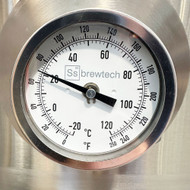Check You Are Pitching Enough Yeast
Use an online tool to check how much yeast you need to use. You’ll be surprised, it’s probably more than you think. Under-pitching yeast will create yeast stress and off-flavours. That “unique” flavour in your beer might disappear if you use more yeast in your next brew. Generally it is easy to under-pitch yeast but hard to over-pitch. An online tool will allow you to plug in variables like volume, gravity, temperature, and style and suggest the right amount to add.
Add Oxygen At The Beginning
Yeast needs oxygen at the beginning to create a healthy ferment. Ideally you would have 8-10ppm in the liquid - shaking or splashing will get you some of the way but an oxygenation kit is the only way to get the right amount into the solution. Just don’t add oxygen after fermentation!
Temperature Control is Essential
Don’t listen to your grandfather’s advice and wrap your fermenter in an electric blanket and place it in the hot water cupboard! You’ll cook the yeast and wonder why your beer tastes like rubber. Fermentation for most beer styles needs to be relatively cool and consistent – 10-14°C for lagers and 18-21°C for ales as a rough guide. While your fermentation may have started at 18°C, without temperature control the yeast will create its own thermal heat and that may rise to 25°C without you knowing.
Reuse Your Sanitiser
No need to make up a batch of sanitising solution each time you brew - make up a bucket of it and use it over your brewing surfaces as needed and return to the bucket. Your gear should be clean by this point so the solution shouldn’t get dirty. A little bit of Star San or Stellarsan can go a long way, and by reusing you’ll save time and money.
Start Kegging
Stop bottling your beer, start kegging and you’ll never look back. A small investment in a basic keg set-up with save you time and allow you to have a perfect pour.
Ramp Up The Fermentation Temperature
Raise the temperature by a couple of degrees near the end of fermentation. This is called a diacetyl rest, and is a common method to avoid diacetyl - an off-flavour in most beer styles that tastes like butterscotch or buttered popcorn. Hold the beer at the higher temperature for 2-3 days and ensure final gravity has been reached.
